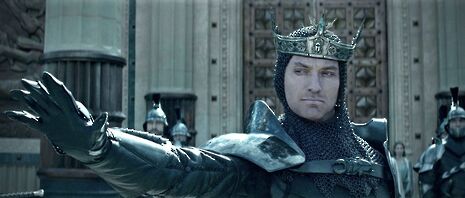Preview: ‘King Arthur: Legend of the Sword’
Through an excruciating din, Lillian Crawford attempts to recollect her senses following a mind-bogglingly awful fantasy adventure with a band of Arthurian Cockneys

Fading in from black, the beacon is lit. Into the scene strolls an Oliphant on speed, bearing a flaming pyramid containing Mordred in full Mola Ram garb on its back. As the prologue unfurls, the Lord of the Rings/Indiana Jones/Game of Thrones parallels continue. For this is the Legend of the Sword, the eponymous weapon bearing an uncanny resemblance to the hallucinogenic powers of the One Ring itself, as the Lady of the Lake presents Galadriel-esque exposition in this smeary, CGI-fuelled Camelot. It seems ironic that Guy Ritchie has infused his latest passion project with imagery of the greatest works of the genre, when this might possibly be the worst.
“Against a backdrop of some of the worst CGI ever put to screen, the battles rattle the ear drums and batter the eyes, thrusting back-and-forth with ever-increasing ferocity.”
Despite being the film’s only known star, Jude Law is hardly at his best, a Dom Hemingway in chainmail. Nevertheless, his acting might be considered genius compared with the rest of this ensemble of obscurities, surely to be condemned to a blacklist of B-movie gangster flicks. The motley crew is led by Charlie Hunnam as Arthur Pendragon, a bastard raised in a nauseating Karate Kid montage that hurls Londinium up to date. His accent changing as quickly as the camera, the legend merges with Legend, as the titular king becomes more Reggie Kray than gallant knight. Ritchie’s film roots are made clear, Snatch thrust into the halls of castles, the fabled knights nothing but petty hustlers. Amongst them Bleu Landau defines the stereotype of the bad child actor, and Astrid Bergès-Frisbey gives a more wooden performance than her staff. The less said of David Beckham’s cameo the better.
As we plough through alleys attached to Arthur’s shoulder as if filmed by a Go-Pro, stomachs begin to turn. For a film presented with Ritchie’s usual grit, there is a notable absence of blood, although there is plenty to sicken here. Against a backdrop of some of the worst CGI ever put to screen, the battles rattle the ear drums and batter the eyes, thrusting back-and-forth with ever-increasing ferocity. In the rare but painfully drawn out moments of dialogue, Ritchie treats us to Arthurian ‘lad-culture’ and misogyny which our lives would be better off without. Highlights include “honey-tits” and those well-known Old English words like “mate” that baffle an already confused screenplay. When female characters are present, they tend to be used as sacrifices or “tools”. Historical accuracy has clearly been trodden deep into the mud, rendering this objectification appallingly unnecessary.
Looking back at other cinematic takes on the tales of the Knights of the Round Table, King Arthur: Legend of the Sword is cemented at the bottom of the heap. With coconuts for horses, Monty Python and the Holy Grail proved that less can often be more, and where Ritchie’s slapstick might make a teenager smirk, none of the ‘gags’ come close to the Knights who say “Ni!” or the infamous Black Knight. Even giant snakes and faceless bats fall short of the terrifying realism of Python’s killer rabbit. If you are thinking of seeing this, do your head a favour and watch the comedy classic instead.
Despite ‘borrowing’ heavily from classic fantasy films, Ritchie’s bizarre rags-to-riches narrative renders this an abysmal tale of Arthurian social mobility that should have been left on the cutting room floor
 Comment / Plastic pubs: the problem with Cambridge alehouses 5 January 2026
Comment / Plastic pubs: the problem with Cambridge alehouses 5 January 2026 News / Cambridge academics stand out in King’s 2026 Honours List2 January 2026
News / Cambridge academics stand out in King’s 2026 Honours List2 January 2026 News / Cambridge businesses concerned infrastructure delays will hurt growth5 January 2026
News / Cambridge businesses concerned infrastructure delays will hurt growth5 January 2026 News / AstraZeneca sues for £32 million over faulty construction at Cambridge Campus31 December 2025
News / AstraZeneca sues for £32 million over faulty construction at Cambridge Campus31 December 2025 Interviews / You don’t need to peak at Cambridge, says Robin Harding31 December 2025
Interviews / You don’t need to peak at Cambridge, says Robin Harding31 December 2025








